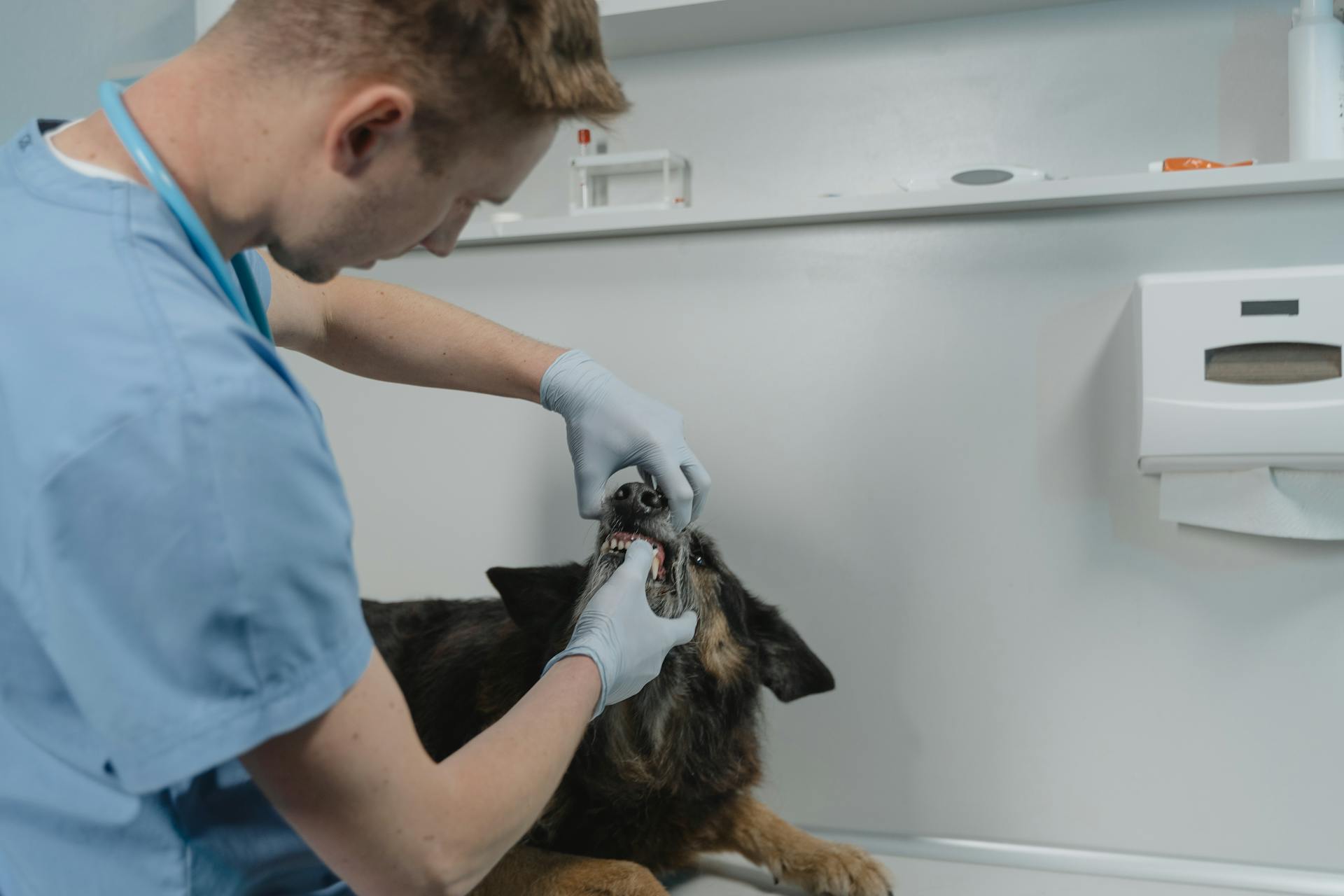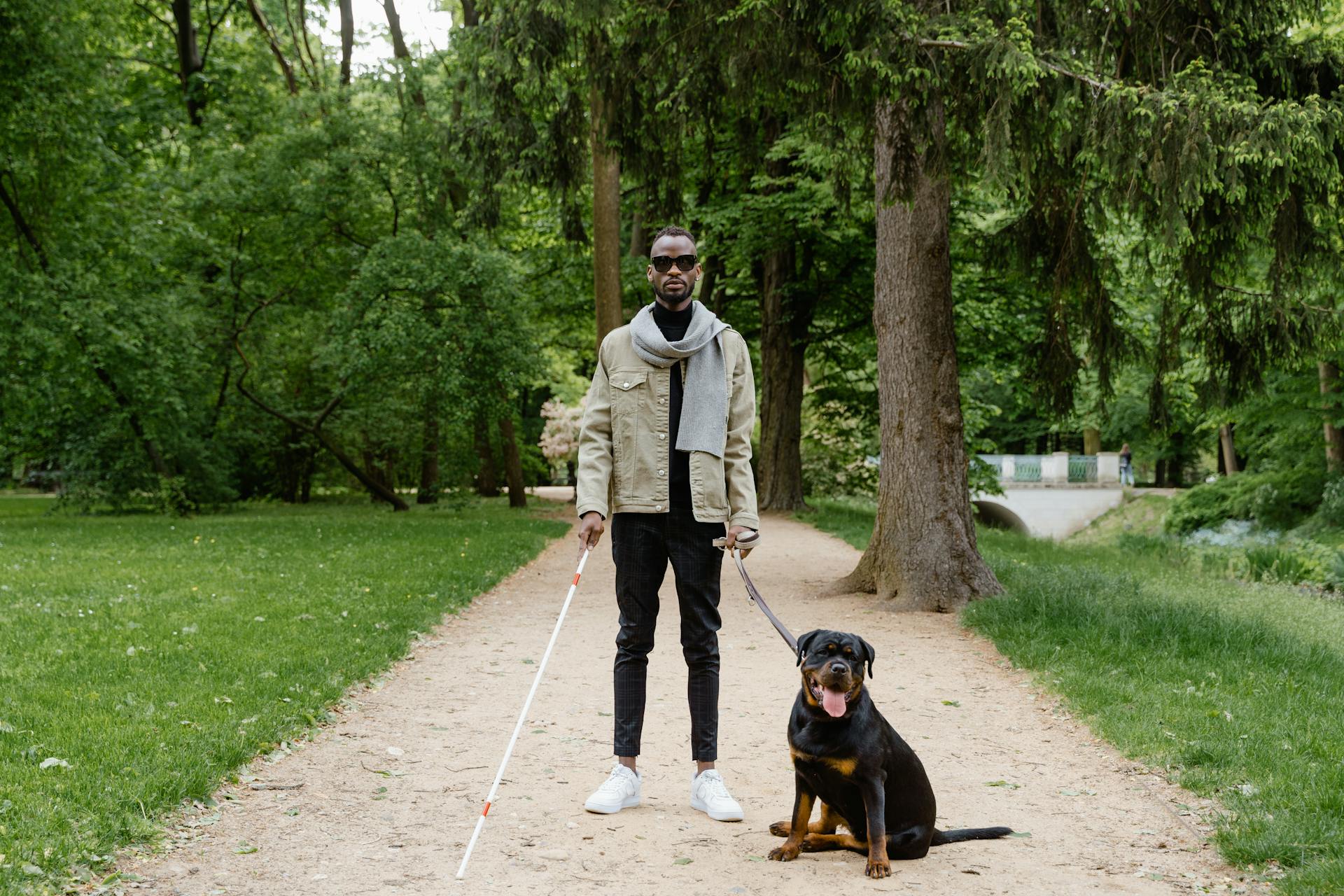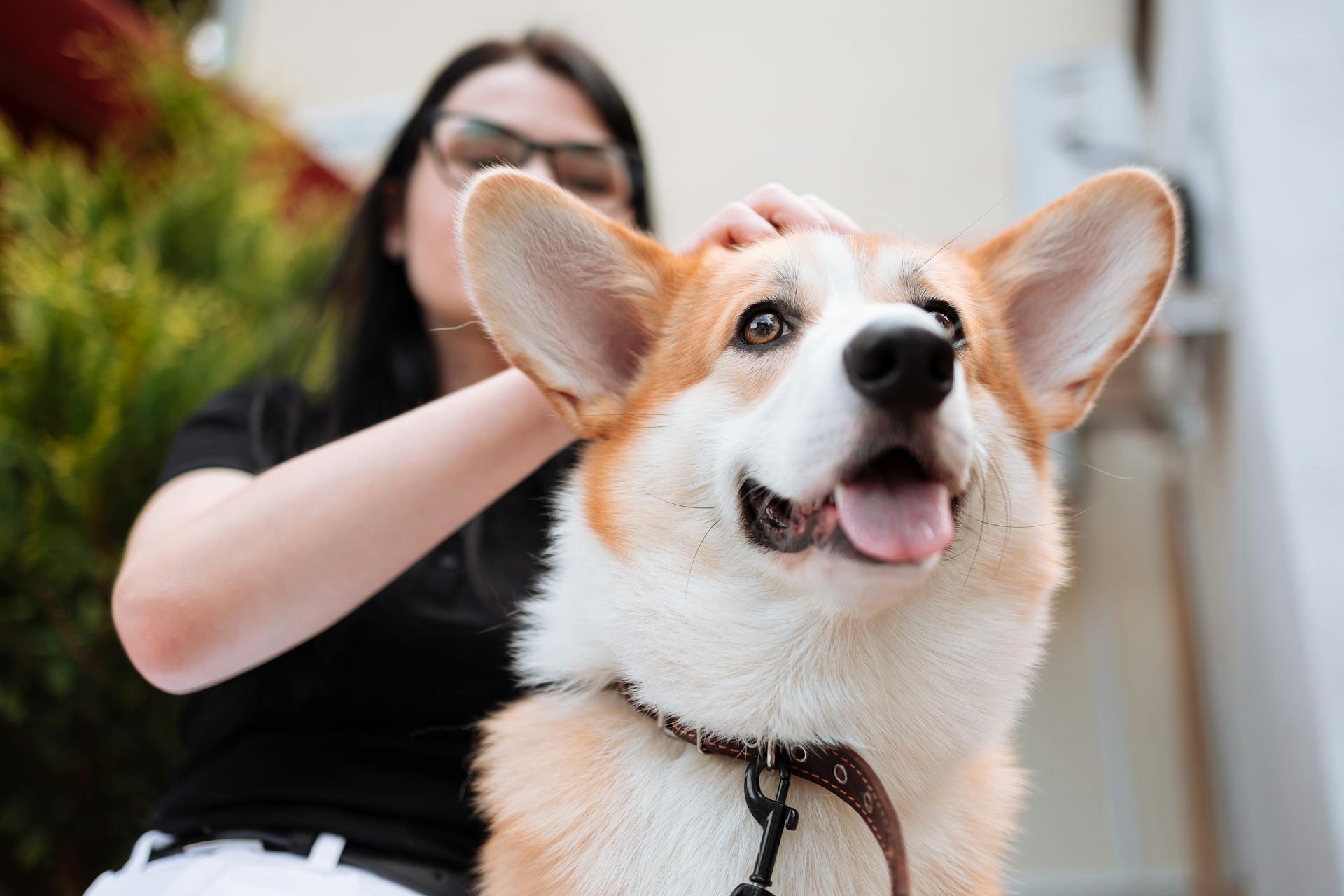
Dogs with dementia often experience changes in their gait and mobility, which can be particularly noticeable in their back legs.
As they age, their back legs may become weaker and more unsteady, making it difficult for them to walk or even stand.
A common sign of dog dementia is a decrease in mobility, which can be seen in the way they move their back legs.
In some cases, dogs may even drag their back legs behind them, a clear indication that something is amiss.
Understanding Dog Dementia
Dog dementia, also known as Canine Cognitive Dysfunction (CCD), is a common condition in older dogs. It's a natural part of aging, just like it is in humans.
Research has shown that dogs with CCD experience changes in the brain, including brain atrophy, where brain cells die, and an abnormal protein called beta amyloid builds up. This protein buildup can lead to decreased nerve signaling in the brain.
Dogs with epilepsy and those who lead a sedentary lifestyle are at a higher risk of developing CCD. Maintaining a healthy and stimulating environment can help slow the progression of cognitive decline. This includes a daily routine of exercise, play, and mental stimulation.
Here are some common symptoms of dog dementia:
- Disorientation/confusion
- Changes in behavior
- Anxiety/restlessness/Impaired memory
- Changes in sleep cycle
Your veterinarian will perform a complete physical examination, routine blood tests, and other diagnostic tests to rule out other diseases that may be causing the behavioral changes. They may also recommend advanced imaging like an MRI or CT scan.
Signs of Dementia
Signs of Dementia in Dogs can be a real challenge for pet owners. Disorientation and confusion are common symptoms, where your dog may seem lost or unsure of their surroundings.
Changes in behavior are another sign, and this can manifest in different ways, such as increased anxiety or restlessness. You may notice your dog pacing back and forth or becoming easily agitated.
Anxiety, restlessness, and impaired memory are all closely related symptoms. Your dog may have trouble remembering familiar commands or routines, or they may become anxious in situations that previously didn't faze them.
Changes in sleep cycle are also a common sign of dementia in dogs. You may notice your dog sleeping more or less than usual, or they may have trouble settling down to sleep.
Here are the most common symptoms of dementia in dogs:
- Disorientation/confusion
- Changes in behavior
- Anxiety/restlessness/Impaired memory
- Changes in sleep cycle
Causes of Dementia
As dogs age, their brains undergo changes that can lead to dementia. Brain atrophy, or the shrinking of brain cells, is a common occurrence in older dogs, affecting areas responsible for learning and memory.
This atrophy can cause a gradual loss of brain function, resulting in noticeable "old age" symptoms. The brain's cerebral cortex, which handles learning and memory, is particularly affected.
Dogs with dementia also have an abnormal protein called beta amyloid building up in their brains. This protein buildup disrupts nerve signaling and contributes to the decline in cognitive function.
High levels of monoamine oxidase B (MAOB) in the brain can also degrade neurotransmitters, further exacerbating the problem. This can lead to a decrease in dopamine levels, an essential neurotransmitter for brain function.
Dogs with epilepsy and those who lead sedentary lifestyles are at a higher risk of developing dementia. A sedentary lifestyle can contribute to weight gain and other health issues that may increase the likelihood of dementia.
Here are some key changes that occur in the brain as dogs age:
- Brain atrophy: Changes in the weight and size of the brain area and reduced number of brain cells.
- Increased beta amyloid plaques: A protein that accumulates in the brain and damages cells.
- Micro hemorrhages or disrupted blood flow: Compromising the blood flow and oxygen needed for a healthy brain.
- Changes to neurotransmitter levels: High levels of MAOB result in lowered dopamine levels.
Diagnosis and Treatment
Diagnosing dog dementia requires a thorough discussion with your veterinarian, who may refer you to a specialist for further evaluation.
Your veterinarian will perform a complete neurological exam, which may include X-rays, MRI, and CT scans, as well as special blood tests to assist with diagnosis.
A complete neurological exam will help identify the extent of your dog's condition and determine the best course of treatment.
Your veterinarian may also take samples of your dog's spinal fluid to aid in diagnosis.
Suggestion: Will Dog's Hair Grow Back after Scab?
Any changes in your dog's behavior should be reported to your veterinarian immediately, as geriatric dogs can be prone to serious changes.
A balanced diet rich in antioxidants and fatty acids can help fight the free radicals that are attacking your dog's brain.
Your veterinarian may recommend a special diet, such as Hills' b/d, Royal Canin's Mature Consult, or Purina Pro Plan's Neurocare, to improve your dog's cognitive function.
Supplements such as omega fatty acids, melatonin, vitamin B, and S-adenosylmethionine (SAM-e) may also be beneficial in managing your dog's symptoms.
Medication, such as Anipryl (selegeline), may be necessary to help prolong dopamine activity in the brain and alleviate symptoms.
Treatment for dog dementia is highly dependent on symptoms and a thorough discussion with your veterinarian is needed before treatment begins.
A home with a daily routine of exercise, play, and mental stimulation can help slow the progression of cognitive decline.
Making your home more accessible and safer for your senior dog can also help, with features such as night lights, potty pads, and orthopedic foam beds.
Take a look at this: How Much Does It Cost to Amputate a Dog's Leg?
Here are some general guidelines for creating a safe and accessible home for your senior dog:
- Night lights can help your senior dog navigate in the dark.
- Potty pads near doors give your pup a place to go if they can’t make it until you come home or wake up.
- Orthopedic foam beds (with washable covers) can make sleep more comfortable.
Regular check-ups with your veterinarian are essential to monitor your dog's response to therapy and the progression of symptoms.
Case Study: Mitsy
Mitsy's story is a powerful example of how dog dementia can affect a dog's mobility. Mitsy, a 12-year-old Labrador Retriever, began showing signs of cognitive decline, including confusion and disorientation.
Her owners noticed that Mitsy would often stumble and have trouble walking, which was likely due to her age-related cognitive decline.
Mitsy's case study highlights the importance of recognizing the early signs of dog dementia, which can include changes in gait and mobility.
As Mitsy's dementia progressed, her owners reported that she would often forget how to walk or would have trouble standing up from a lying down position.
Back-Leg Weakness and Neurological Disorders
If your dog is experiencing back-leg weakness, it could be a sign of a neurological disorder. Changes in the activity level, reluctance to venture out, and spinal pain are all symptoms that can be associated with neurological disorders.
Limb weakness and balance problems are common symptoms, which can cause your dog to wobble and have an unsteady gait. This can make everyday activities, like walking or playing, challenging and even painful for your dog.
A neurological exam, including X-rays, MRI, and CT scans, can help diagnose the underlying cause of back-leg weakness. Your veterinarian may also perform special blood tests and collect a sample of your dog's spinal fluid to aid in diagnosis.
Here are some common causes of back-leg weakness in dogs:
- Brain atrophy - a gradual loss of brain function
- Increased beta amyloid plaques - a protein that accumulates in the brain and damages cells
- Changes to the neurotransmitter levels - high levels of MAOB can lower dopamine levels
Early intervention and treatment can help manage the condition and improve your dog's quality of life. A diet rich in antioxidants and fatty acids, combined with regular exercise and mental stimulation, can help slow the progression of neurological disorders.
Causes of Back-Leg Weakness
Back-Leg Weakness can be caused by a variety of conditions, including IVDD, Degenerative Myelopathy, FCE, Arthritis, and more.
IVDD, or intervertebral disc disease, can cause a sudden loss of function in a dog's hind limbs, often without warning. This is an emergency situation that requires immediate veterinary attention.
Degenerative Myelopathy is another condition that can cause back-leg weakness, and it's most common in breeds like German Shepherds. It's a serious condition that requires prompt treatment.
FCE, or fibrocartilaginous embolism, can also cause sudden limb weakness in dogs. This is a vascular event that can have severe consequences if not treated promptly.
Arthritis is a common cause of back-leg weakness in older dogs, and it's often a slow progression. Almost all dogs will show signs of arthritis if you look closely enough, but not all of them will have mobility problems.
Here are some of the possible causes of back-leg weakness in dogs:
- IVDD (intervertebral disc disease)
- Degenerative Myelopathy
- FCE (fibrocartilaginous embolism)
- Arthritis
- Infections or inflammatory processes, including meningitis or encephalitis
- Hip dysplasia
- Tumors
- Injuries (like tears to ligaments or tendons)
Neurological Disorder Symptoms
As your dog ages, it's essential to be aware of the symptoms of neurological disorders. Changes in activity level, such as reluctance to venture out or join in high-energy activities, are common.
Reluctance to join in activities can be a sign of neurological decline. You may notice your dog's sleep pattern changing, with them sleeping more or less than usual.
Wandering around at night, spinal pain, and limb weakness are also potential symptoms. A lack of coordination and balance problems, such as wobbling and an unsteady gait, can be concerning.
Urinary or fecal incontinence, vision loss or impairment, convulsive seizures, and disorientation can all be signs of neurological issues. Lethargy and anxiety can also be indicative of a problem.
Here are some common symptoms of neurological disorders in dogs:
- Changes in activity level
- Reluctance to venture out or join in high-energy activities
- Changes in sleep pattern
- Wandering around during the night
- Spinal pain
- Limb weakness
- Lack of coordination
- Balance problems such as wobbling and unsteady gait
- Urinary or fecal incontinence
- Vision loss or impairment
- Convulsive seizures
- Disorientation
- Lethargy
- Anxiety
These symptoms can be attributed to various neurological diseases, including Cognitive Dysfunction Syndrome (CDS), which is a neurodegenerative disease caused by reduced cerebral blood flow to the brain and an accumulation of free radicals.
Neurological Disorders Diagnosis
Diagnosing neurological disorders in dogs requires a thorough approach. A specialist in veterinary medicine will work with your local veterinarian to determine the best course of action.
Providing as much information as possible to the specialist is crucial. Noting any unusual behavior and when it began, or even recording a video of your dog acting differently can be incredibly helpful.

A complete neurological exam will be performed, which may include X-rays, MRI, and CT scans. Special blood tests may also be necessary to assist with diagnosis.
Taking samples of your dog's spinal fluid may be required. This can be a challenging process, but it's an important step in determining the underlying cause of the neurological disorder.
The earlier you notice changes in your dog's behavior, the easier and more effective it is to provide treatment. This is why it's essential to be observant and report any unusual behavior to your veterinarian as soon as possible.
Frequently Asked Questions
What do you do when an old dog's back legs give out?
Take your dog to a pet emergency hospital or your regular vet immediately if their back legs suddenly collapse. Prompt action can help determine if surgery is needed to treat IVDD
How long can dogs live with weak back legs?
Dogs with degenerative myelopathy typically live 1-2 years after diagnosis, during which time their condition will progressively worsen. Understanding the disease and its progression can help you provide the best possible care for your dog.
Sources
- https://www.petmd.com/dog/conditions/neurological/dog-dementia
- https://journal.iaabcfoundation.org/caring-for-dogs-with-advanced-dementia/
- https://www.thefarmersdog.com/digest/what-to-do-if-your-senior-dogs-back-legs-are-collapsing/
- https://wagwalking.com/condition/neurological-disorders-aging
- https://www.undertheweatherpet.com/blogs/under-the-weather/recognizing-the-signs-of-doggie-dementia
Featured Images: pexels.com


